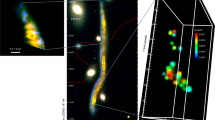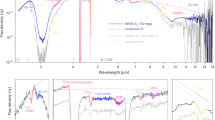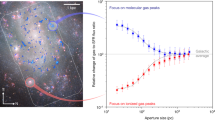Abstract
Brown dwarfs—substellar bodies more massive than planets but not massive enough to initiate the sustained hydrogen fusion that powers self-luminous stars1,2—are born hot and slowly cool as they age. As they cool below about 2,300 kelvin, liquid or crystalline particles composed of calcium aluminates, silicates and iron condense into atmospheric ‘dust’3,4, which disappears at still cooler temperatures (around 1,300 kelvin)5,6. Models to explain this dust dispersal include both an abrupt sinking of the entire cloud deck into the deep, unobservable atmosphere5,7 and breakup of the cloud into scattered patches6,8 (as seen on Jupiter and Saturn9). However, hitherto observations of brown dwarfs have been limited to globally integrated measurements10, which can reveal surface inhomogeneities but cannot unambiguously resolve surface features11. Here we report a two-dimensional map of a brown dwarf’s surface that allows identification of large-scale bright and dark features, indicative of patchy clouds. Monitoring suggests that the characteristic timescale for the evolution of global weather patterns is approximately one day.
This is a preview of subscription content, access via your institution
Access options
Subscribe to this journal
Receive 51 print issues and online access
$199.00 per year
only $3.90 per issue
Buy this article
- Purchase on Springer Link
- Instant access to full article PDF
Prices may be subject to local taxes which are calculated during checkout


Similar content being viewed by others
References
Kumar, S. S. The structure of stars of very low mass. Astrophys. J. 137, 1121–1125 (1963)
Becklin, E. E. & Zuckerman, B. A low-temperature companion to a white dwarf star. Nature 336, 656–658 (1988)
Lunine, J. I., Hubbard, W. B. & Marley, M. S. Evolution and infrared spectra of brown dwarfs. Astrophys. J. 310, 238–260 (1986)
Kirkpatrick, J. D. et al. Dwarfs cooler than “M”: the definition of spectral type “L” using discoveries from the 2 Micron All-Sky Survey (2MASS). Astrophys. J. 519, 802–833 (1999)
Stephens, D. C. et al. The 0.8–14.5 μm spectra of mid-L to mid-T dwarfs: diagnostics of effective temperature, grain sedimentation, gas transport, and surface gravity. Astrophys. J. 702, 154–170 (2009)
Burgasser, A. J. et al. Evidence of cloud disruption in the L/T dwarf transition. Astrophys. J. 571, L151–L154 (2002)
Tsuji, T., Nakajima, T. & Yanagisawa, K. Dust in the photospheric environment. II. Effect on the near-infrared spectra of L and T dwarfs. Astrophys. J. 607, 511–529 (2004)
Ackerman, A. S. & Marley, M. S. Precipitating condensation clouds in substellar atmospheres. Astrophys. J. 556, 872–884 (2001)
Fletcher, L. N. et al. Retrievals of atmospheric variables on the gas giants from ground-based mid-infrared imaging. Icarus 200, 154–175 (2009)
Buenzli, E. et al. Vertical atmospheric structure in a variable brown dwarf: pressure-dependent phase shifts in simultaneous Hubble Space Telescope-Spitzer light curves. Astrophys. J. 760, L31–L36 (2012)
Apai, D. et al. HST spectral mapping of L/T transition brown dwarfs reveals cloud thickness variations. Astrophys. J. 768, 121–136 (2013)
Luhman, K. L. Discovery of a binary brown dwarf at 2 pc from the Sun. Astrophys. J. 767, L1–L6 (2013)
Kniazev, A. Y. et al. Characterization of the nearby L/T binary brown dwarf WISE J104915.57–531906.1 at 2 pc from the Sun. Astrophys. J. 770, 124–128 (2013)
Burgasser, A. J., Sheppard, S. S. & Luhman, K. L. Resolved near-infrared spectroscopy of WISE J104915.57–531906.1AB: a flux-reversal binary at the L dwarf/T dwarf transition. Astrophys. J. 772, 129–135 (2013)
Gillon, M. et al. Fast-evolving weather for the coolest of our two new substellar neighbours. Astron. Astrophys. 555, L5–L8 (2013)
Käufl, H.-U. et al. CRIRES: a high-resolution infrared spectrograph for ESO's VLT. Proc. SPIE 5492, 1218–1227 (2004)
Burrows, A., Heng, K. & Nampaisarn, T. The dependence of brown dwarf radii on atmospheric metallicity and clouds: theory and comparison with observations. Astrophys. J. 736, 47–60 (2011)
Biller, B. A. et al. Weather on the nearest brown dwarfs: resolved simultaneous multi-wavelength variability monitoring of WISE J104915.57–531906.1AB. Astrophys. J. 778, L10–L16 (2013)
Wheelwright, H. E., Vink, J. S., Oudmaijer, R. D. & Drew, J. E. On the alignment between the circumstellar disks and orbital planes of Herbig Ae/Be binary systems. Astron. Astrophys. 532, A28 (2011)
Vogt, S. S., Penrod, G. D. & Hatzes, A. P. Doppler images of rotating stars using maximum entropy image reconstruction. Astrophys. J. 321, 496–515 (1987)
Rice, J. B., Wehlau, W. H. & Khokhlova, V. L. Mapping stellar surfaces by Doppler imaging—technique and application. Astron. Astrophys. 208, 179–188 (1989)
Agúndez, M. et al. The impact of atmospheric circulation on the chemistry of the hot Jupiter HD 209458b. Astron. Astrophys. 548, A73 (2012)
Cho, J. Y.-K., Menou, K., Hansen, B. M. S. & Seager, S. The changing face of the extrasolar giant planet HD 209458b. Astrophys. J. 587, L117–L120 (2003)
Showman, A. P. & Kaspi, Y. Atmospheric dynamics of brown dwarfs and directly imaged giant planets. Astrophys. J. 776, 85–103 (2013)
Vasavada, A. R. & Showman, A. P. Jovian atmospheric dynamics: an update after Galileo and Cassini. Rep. Prog. Phys. 68, 1935–1996 (2005)
Freytag, B., Allard, F., Ludwig, H.-G., Homeier, D. & Steffen, M. Radiation-hydrodynamics simulations of cool stellar and substellar atmospheres. ASP Conf. Ser. 448, 855–862 (2011)
Collier Cameron, A. & Unruh, Y. C. Doppler Images of AB Doradus. Mon. Not. R. Astron. Soc. 269, 814–836 (1995)
Artigau, É., Donati, J.-F. & Delfosse, X. Planet detection, magnetic field of protostars and brown dwarfs meteorology with SPIRou. ASP Conf. Ser. 448, 771–778 (2011)
Majeau, C., Agol, E. & Cowan, N. B. A two-dimensional infrared map of the extrasolar planet HD 189733b. Astrophys. J. 747, L20–L24 (2012)
de Wit, J., Gillon, M., Demory, B.-O. & Seager, S. Towards consistent mapping of distant worlds: secondary-eclipse scanning of the exoplanet HD 189733b. Astron. Astrophys. 548, A128 (2012)
Blake, C. H., Charbonneau, D., White, R. J., Marley, M. S. & Saumon, D. Multiepoch radial velocity observations of L dwarfs. Astrophys. J. 666, 1198–1204 (2007)
Bean, J. L. et al. The CRIRES search for planets around the lowest-mass stars. I. High-precision near-infrared radial velocities with an ammonia gas cell. Astrophys. J. 713, 410–422 (2010)
Hinkle, K. H., Wallace, L. & Livingston, W. Atmospheric transmission above Kitt Peak, 0.5 to 5.5 microns. Bull. Am. Astron. Soc. 35, 1260 (2003) </cit-tl>
Allard, F., Homeier, D., Freytag, B., Schaffenberger, W. & Rajpurohit, A. S. Progress in modeling very low mass stars, brown dwarfs, and planetary mass objects. Mem. Soc. Astron. Ital. 24, (Suppl.), 128–139 2013)
Grey, D. F. The Observation and Analysis of Stellar Photospheres 3rd edn, Ch. 18 (Cambridge Univ. Press, 2005)
Jones, H. R. A. et al. Carbon monoxide in low-mass dwarf stars. Mon. Not. R. Astron. Soc. 358, 105–112 (2005)
Schweitzer, A. et al. Effective temperatures of late L dwarfs and the onset of methane signatures. Astrophys. J. 566, 435–441 (2002)
Konopacky, Q. M. et al. High-precision dynamical masses of very low mass binaries. Astrophys. J. 711, 1087–1122 (2010)
Dupuy, T. J. & Liu, M. C. On the distribution of orbital eccentricities for very low-mass binaries. Astrophys. J. 733, 122–135 (2011)
Donati, J.-F., Semel, M., Carter, B. D., Rees, D. E. & Collier Cameron, A. Spectropolarimetric observations of active stars. Mon. Not. R. Astron. Soc. 291, 658–682 (1997)
Foreman-Mackey, D., Hogg, D. W., Lang, D. & Goodman, J. emcee: The MCMC hammer. Publ. Astron. Soc. Pacif. 125, 306–312 (2013)
Vogt, S. S. Doppler images of spotted late-type stars. In The Impact of Very High S/N Spectroscopy on Stellar Physics 253–272 (Proc. 132nd Symp. Int. Astron. Union, 1988).
Narayan, R. & Nityananda, R. Maximum entropy image restoration in astronomy. Annu. Rev. Astron. Astrophys. 24, 127–170 (1986)
Rice, J. B. Doppler imaging of stellar surfaces—techniques and issues. Astron. Nachr. 323, 220–235 (2002)
Rice, J. B. & Strassmeier, K. G. Doppler imaging from artificial data. Testing the temperature inversion from spectral-line profiles. Astron. Astrophys. 147 (Suppl.). 151–168 (2000)
Unruh, Y. C. & Collier Cameron, A. The sensitivity of Doppler imaging to line profile models. Mon. Not. R. Astron. Soc. 273, 1–16 (1995)
Freytag, B., Allard, F., Ludwig, H.-G., Homeier, D. & Steffen, M. The role of convection, overshoot, and gravity waves for the transport of dust in M dwarf and brown dwarf atmospheres. Astron. Astrophys. 513, A19 (2010)
Draegert, D. A. & Williams, D. Collisional broadening of CO absorption lines by foreign gases. J. Opt. Soc. Am. 58, 1399–1403 (1968)
Bouanich, J. Détermination expérimentale des largeurs et des déplacements des raies de la bande 0 → 2 de co pertubé par les gaz rares (He, Ne, Ar, Kr, Xe). J. Quant. Spec. Radiat. Transf. 12, 1609–1615 (1972)
Malathy Devi, V. et al. Spectral line parameters including temperature dependences of self- and air-broadening in the 2 → 0 band of CO at 2.3 micron. J. Quant. Spec. Radiat. Transf. 113, 1013–1033 (2012)
Faure, A., Wiesenfeld, L., Drouin, B. J. & Tennyson, J. Pressure broadening of water and carbon monoxide transitions by molecular hydrogen at high temperatures. J. Quant. Spec. Radiat. Transf. 116, 79–86 (2013)
Predoi-Cross, A., Bouanich, J. P., Benner, D. C., May, A. D. & Drummond, J. R. Broadening, shifting, and line asymmetries in the 2 ← 0 band of CO and CO–N2: experimental results and theoretical calculations. J. Chem. Phys. 113, 158–168 (2000)
Acknowledgements
We thank A. Hatzes for advice on Doppler imaging analysis, J. Smoker for helping to plan and execute our observations and E. Mills for help in designing figures. This work is based on Director’s Discretionary observations made with the European Southern Observatory Telescopes at the Paranal Observatory under programme ID 291.C-5006(A); data are available in the European Southern Observatory Data Archive at http://archive.eso.org/. D.H. received support from the European Research Council under the European Community’s Seventh Framework Programme (FP7/2007-2013 Grant Agreement number 247060). M.B., D.H. and F.A. acknowledge support from the French National Research Agency (ANR) through project grant ANR10-BLANC0504-01. E.B. is supported by the Swiss National Science Foundation (SNSF). Atmosphere models have been computed on the Pôle Scientifique de Modélisation Numérique at the Ecole Normale Supérieure (ENS) de Lyon, and at the Gesellschaft für Wissenschaftliche Datenverarbeitung Göttingen in co-operation with the Institut für Astrophysik Göttingen. IRAF (the Image Reduction and Analysis Facility) is distributed by the National Optical Astronomy Observatory, which is operated by the Association of Universities for Research in Astronomy (AURA) under cooperative agreement with the National Science Foundation. PyRAF (Python-based IRAF) is a product of the Space Telescope Science Institute, which is operated by AURA for NASA. We also thank contributors to SciPy, Matplotlib, AstroPy and the Python programming language.
Author information
Authors and Affiliations
Contributions
I.J.M.C. coordinated the project and conducted all analyses. I.J.M.C., B.B., J.E.S., N.R.D., M.B., W.B., B.G. and T.K. assisted in obtaining the spectroscopic observations. I.J.M.C., B.B., J.E.S., N.R.D., M.B., D.H., F.A., E.B., Th.H. and W.B. contributed to the manuscript. J.E.S. provided an independent analysis of the projected rotational velocity and radial velocity of both brown dwarfs. B.B. and N.R.D. provided advice on binary dynamics. D.H. and F.A. provided advice on brown dwarf atmospheric processes and the spectral models used for the data calibration, least squares deconvolution and Doppler imaging.
Corresponding author
Ethics declarations
Competing interests
The authors declare no competing financial interests.
Extended data figures and tables
Extended Data Figure 1 Spectral calibration for Luhman 16A (a and b) and Luhman 16B (c and d).
The red curves (a and c) show the modelled spectra, which mostly overlap the observed spectra (plotted in black). The gaps in the spectra correspond to physical spaces between the four infrared array detectors. The residuals to the fits (b and d) are generally a few per cent, with larger deviations apparent near CO bandheads (for example, at 2.294 µm and 2.323 µm) and strong telluric absorption lines (for example, at 2.290 µm and 2.340 µm).
Extended Data Figure 2 Calibrated spectra of the brown dwarfs, showing the individual calibrated spectra of Luhman 16A (a) and Luhman 16B (b).
The time of each observation is indicated.
Extended Data Figure 3 Luhman 16B shows strong rotationally induced variability (b) whereas Luhman 16A does not (a).
The colour scale indicates the deviations from a uniform line profile as measured relative to the line continuum. Luhman 16B’s variations are dominated by a dark region (diagonal streak, corresponding to a decrease of roughly 4% in equivalent width) that comes into view at 1.5 h heading towards the observer, rotates across the brown dwarf to the receding side, and is again hidden behind the limb at 3 h. Brighter regions are visible at earlier and later times, but are less prominent. No significant spectroscopic variability is apparent for Luhman 16A, and no coherent features are seen beyond Luhman 16B’s projected rotational velocity (enclosed between the vertical dashed lines). All these points indicate that we are detecting intrinsic spectroscopic variability from Luhman 16B.
Extended Data Figure 4 Posterior parameter distributions from our single-spot toy model, showing a large mid-latitude spot.
The inner and outer curves in panels a–c indicate the 68.3% and 95.4% confidence regions. The plot shown assumes i = 30 degrees; smaller inclinations result in a slightly more equatorial spot, but the best-fit values remain within the inner 68.3% confidence regions.
Extended Data Figure 5 Simulated brown dwarf with spots, and the map recovered from Doppler imaging.
a, Simulated variable brown dwarf seen at an inclination of i = 30 degrees. The dark and light mid-latitude spots are, respectively, 40% darker and 10% brighter than the photosphere; the dark streak is 10% darker and the polar spot is 20% brighter. b, Surface map recovered from Doppler imaging, assuming noise levels similar to that seen in our observed data, after tuning the hyperparameter a to minimize spurious features. High-contrast features are recovered: the dark spot is in the correct location and the polar spot is only moderately distorted. The equatorial bright spot is visible in the recovered map, but it cannot be reliably distinguished from image artefacts that preferentially cluster near the equator. The dark stripe is not recovered. Thus our analysis can accurately recover strong features, but data quality precludes us from discerning smaller or fainter features.
Extended Data Figure 6 Simulated brown dwarf with spots and bands, and the map recovered from Doppler imaging.
a, Simulated variable brown dwarf with the same surface features as in Extended Data Fig. 5, but now also exhibiting zonal bands with an amplitude of ±20% of the mean photospheric brightness level. b, Surface map recovered from Doppler imaging under the same assumptions as in Extended Data Fig. 5. High-contrast, non-axisymmetric features are recovered as before, but we cannot recover even prominent global bands with the current precision of our data.
PowerPoint slides
Rights and permissions
About this article
Cite this article
Crossfield, I., Biller, B., Schlieder, J. et al. A global cloud map of the nearest known brown dwarf. Nature 505, 654–656 (2014). https://doi.org/10.1038/nature12955
Received:
Accepted:
Published:
Issue Date:
DOI: https://doi.org/10.1038/nature12955
This article is cited by
-
The search for living worlds and the connection to our cosmic origins
Experimental Astronomy (2022)
-
An all-photonic focal-plane wavefront sensor
Nature Communications (2020)
-
Atmospheric Dynamics of Hot Giant Planets and Brown Dwarfs
Space Science Reviews (2020)
Comments
By submitting a comment you agree to abide by our Terms and Community Guidelines. If you find something abusive or that does not comply with our terms or guidelines please flag it as inappropriate.



